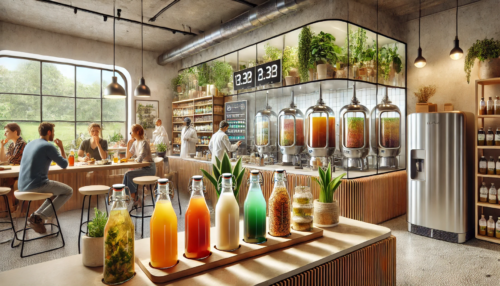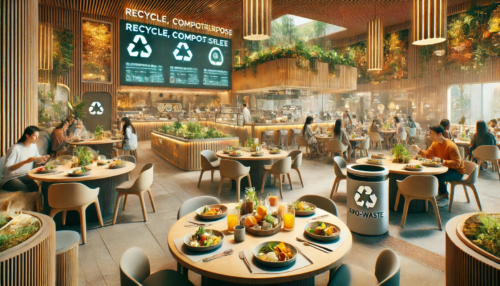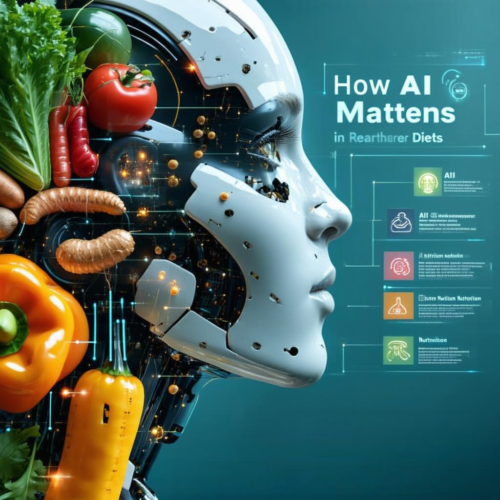Skyward Greens: The 2025 Urban Kitchen Revolution
Do you recall a moment when you picked up a limp lettuce head at the local grocery store and muttered, “Is this really the best they’ve got?” Yeah, me too—over and over. Lately, though, there’s a thrilling shift brewing in big cities all around the globe, one that has sprouted from people’s yearning for vibrant, chemical-free produce. Welcome to the fascinating world of hydroponic and vertical farming for urban kitchens.
The concept, at first, might seem like a smidgen of science fiction: towers of leafy greens perched in your living room, vines weaving up walls, and strawberries winking from LED-lit shelves. Yet, real folks in cramped city apartments are growing luscious spinach, crisp kale, succulent tomatoes, and more—sometimes with just a corner’s worth of free space. Some might call it a horticultural miracle, but I see it more as modern-day resourcefulness and a testament to humankind’s unstoppable curiosity.
But let’s not jump the gun. Before diving in deep, I want to hint at why this realm of vertical and hydroponic farming might be the next big political talking point, how government agencies from the USDA to local city councils are stepping in, and why even a few A-list celebrities are suddenly cropping up on social media boasting about their indoor microgreens. Brace yourself. We’re about to embark on a winding journey of scientific discovery, policy bulletins, and occasional star-studded Instagram stories. At times, we may drift a bit or slip in a corny pun. But hey, that’s life—messy, evolving, and occasionally peppered with half-baked jokes.
New Seeds of Government Policy
The federal stance on hydroponics, especially in the United States, has been gradually morphing into one of measured optimism and regulatory caution. The USDA’s official blog post on vertical farming highlights how indoor farming can boost local economies and increase food security, particularly in urban environments with limited farmland. This push aligns with the global initiative of ensuring reliable food sources in an era of climate unpredictability.
Policy Tidbits & Political Debates
However, the political sphere is not always a utopia of consensus. Some policymakers champion large-scale hydroponic and vertical farms as a partial solution to the looming climate crisis. They argue that reusing water in hydroponics significantly cuts down waste, enabling cities to become resilient against droughts. Detractors, though, question the environmental impact of energy-intensive lighting systems—high electricity consumption from those neon grow-lights can be a thorny topic.
In 2024, a wave of city-level proposals stirred debate in big metros like Los Angeles and New York. Proponents demanded tax incentives to folks who incorporate water-efficient, home-based vertical systems. Skeptics, on the other hand, contended that this approach neglects underserved communities who struggle to afford advanced indoor setups in the first place.
A newly passed draft legislation, tentatively titled “The Urban Micro-Farming Bill,” aims to mitigate costs for new entrants in the hydroponic space. While it’s still in political limbo at certain committees, most government notes reveal a growing consensus: Urban agriculture is more than a short-lived trend; it’s a blueprint for tomorrow’s sustainable living.
FDA Regulations & Food Safety Guidance
The FDA has called for more thorough safety guidelines directed at indoor-farming companies. And for home growers, the line can sometimes blur. What begins as a hobby can balloon into a small business, requiring compliance with basic food safety protocols if you’re selling produce to neighbors. Surprise—there’s some bureaucracy behind that succulent, homegrown basil.
Comparisons have been drawn with standard open-field produce safety measures. In fact, the FSMA Produce Safety Rules and Hydroponics highlight how crucial it is to monitor water quality, even if you’re only nurturing a small herb garden in your kitchen. Government agencies worry that nitrate levels, potential E. coli contamination from unclean water sources, and improper nutrient disposal might overshadow the obvious perks of vertical growing. This caution is not meant to discourage budding hydroponic enthusiasts, but instead to ensure folks recognize their responsibilities.
Interestingly, you will find heated exchanges in political news updates discussing how stringent these regulations should be. Some politicians prefer looser guidelines to promote expansion, while others demand mandated training sessions and periodic water checks. So, even a minuscule city apartment brimming with fresh vegetables might inadvertently become a centerpiece of the next election cycle’s hot debate.
The Research Race: Lab Coats on a Mission
Diving into the realm of scientific inquiry, research labs and scientists have ventured far beyond rummaging for better tomato seeds. According to a detailed publication on ResearchGate, advanced LED engineering and nutrient management approaches are reshaping the synergy between plants and technology. Scientists are tinkering with new nutrient blends, investigating the effect of spectrum-tunable LED lamps on flavor, aroma, and even the vitamin content in vegetables.
I recall visiting a university research lab—where, ironically, half the floor was packed with racks of lettuce. Researchers wore sunglasses because the bright pinkish LED glow was intense enough to remind you of a disco show from the ‘80s. This comedic scene showcased the future: an ever-evolving interplay of biology, chemistry, and engineering. The overarching goal? Achieve greater yields with less resource usage.
NASA and Cosmic Agriculture Dreams
Another angle stirring curiosity is NASA’s interest in controlled-environment agriculture. Space agencies are dabbling in microgravity-based hydroponic systems for potential off-planet applications. Suddenly, the idea of vertical farming in a small city kitchen feels downright ordinary compared to designing a system for Mars missions. But that’s the nature of scientific exploration: from test tubes to rocket fuel, it’s all about discovering uncharted territory.
Star Power: Celebrity Buzz & Bold Announcements
Perhaps you’ve noticed certain high-profile celebrities extolling the virtues of microgreens on their social channels. Kim Teasley—an A-list pop star known for her philanthropic side projects—recently posted on Instagram about how she’s been growing her own kale inside a futuristic glass cylinder. “No more grocery lines for me,” she joked. “I harvest kale in my pajamas.”
Last year, another beloved Hollywood actor turned environmental crusader made a flamboyant statement endorsing vertical farming on talk shows. The celebrity insisted that every new apartment in Los Angeles should have a “built-in living wall” so folks can produce their own pesticide-free lettuces. Some politicians lauded this stance, seizing a prime chance to connect with a broad audience. Others rolled their eyes, dismissing it as a fleeting trend. Nonetheless, these public endorsements carry big social sway, encouraging everyday families to experiment with a tabletop hydroponic kit or a vertical tower.
It’s reminiscent of the days when Hollywood stars started adopting hybrid vehicles, turning them from novelty items into a mainstream phenomenon. If you’re scanning the horizon for the next wave of cultural obsession, indoor agriculture might be it. Perhaps we’re already knee-deep in it, especially as the year 2025 propels us into an era of climate consciousness where folks can’t help but crave fresh, chemical-free options grown right at home.
Practical Approaches for the Urban Kitchen
Now, let’s get down to brass tacks—how exactly do we cultivate these in-city oases? The fundamental principle revolves around water, nutrients, and minimal soil. Actually, the absence of soil in hydroponics was once baffling to me. A friend who introduced me to the technique exclaimed, “Soil is so last century.” I rolled my eyes at first, but after tasting a crisp hydroponic cucumber, I stopped rolling and started munching.
Tower Gardens and Smart Cabinets
Vertical tower gardens (check out the Garden Tower Project’s official product) have become hugely popular for city-dwellers. Tower structures use gravity-fed water systems, delivering nutrient solutions to plants in a closed loop. This method offers minimal water wastage—some folks claim it can reduce water usage by up to 90% compared to conventional soil gardening.
Then you have smart hydroponic cabinets, especially appealing to the super-busy crowd who prefer an almost set-it-and-forget-it system. Equipped with automated lights, timers, and nutrient dispensers, these cabinets allow you to cultivate everything from leafy greens to petite peppers, all while monitoring progress with a smartphone app. Surreal? Absolutely. But it’s real, it’s happening, and it’s kind of wild to witness.
Subtle Contradictions in Urban Farming
Still, let’s not sugarcoat the entire phenomenon. One riddle is the energy usage of LED lights, which, while more efficient than older technologies, can still rack up your utility bills. The debate about whether the net environmental impact is always positive remains unresolved. If your city grid relies mostly on fossil fuels, the carbon savings from not transporting lettuce thousands of miles might be offset by increased electricity consumption. I find it slightly comical that in some cases, an eco-friendly approach might ironically tug at the environment in a different manner.
Another subtle oversight is that while hydroponics drastically cuts water use, it doesn’t always address socio-economic inequalities. A fancy vertical system might cost more than an ordinary city dweller can feasibly invest. That’s why many advocates push for government rebates or low-cost starter kits. Without these solutions, the urban hydroponic revolution might remain out of reach for lower-income families—the very ones who often lack fresh produce access in “food deserts.”
So, yes, everything has a catch. That doesn’t mean we should abandon the mission. Instead, we might need to fine-tune it, ensuring that shiny new technologies don’t overshadow time-tested communal gardening initiatives, or overshadow the real need for broad, equitable distribution of fresh fruits and veggies.
Personal Adventures and Clumsy Moments
Let me confess something: My own foray into hydroponics wasn’t all smooth sailing. I recall gawking at fancy setups online, imagining an indoor jungle. But once I got everything installed, I realized I had left out one tiny detail: my cat. My ever-curious feline decided to nibble on the baby lettuce sprouts. It was a comedic fiasco. Also, one of my tomato vines outgrew its space and toppled a nearby lamp. A swirl of half-lucid panic ensued. But such misadventures are part of the learning curve. If you’re planning your own indoor farm, maybe keep your furry friends at bay or pick cat-friendly greens.
Another friend of mine who jumped on the bandwagon installed a large vertical shelf near her window. She was so excited she forgot to think about the glare from the LED lights at night—her neighbors across the street politely complained about the unintentional disco effect. So, do a quick mental check: Will your neighbors be able to see that pink glow? Are you prepared for a potential facepalm scenario?
Government Grants and Political Forecast
From a more visionary standpoint, local governments in major urban centers are beginning to earmark grants and resources for hydroponic research. Politically, it’s become a sweet-spot platform for candidates who wish to appear eco-friendly and pro-innovation. And we’re no strangers to certain campaign promises that revolve around installing small-scale vertical farms in public schools and community centers, aiming to teach kids about sustainability. Will all these pledges see the light of day? Possibly. Political promises can be slippery, but the momentum is there.
Just recently, an influential senator proposed a bill to offer free or heavily discounted equipment to libraries and community centers across the state. If you’re a local city manager, you might soon be required to demonstrate vertical garden feasibility in municipal buildings. The future might unfold with big, bold expansions or maybe marginal half-steps. Either way, it’s on the docket.
Weaving Science, Politics, and Pop Culture
Somewhere between talk-show flamboyance, starchy legislative texts, and earnest lab experiments, hydroponic and vertical farming for urban kitchens is weaving itself into our social tapestry. You’ll see it in the news, argued in city council halls, tested in shining laboratories, and praised by glamorous celebrities—some of whom might not even know the difference between basil and oregano but still champion the movement wholeheartedly.
It’s kind of thrilling, if you think about it, that an indoor tomato plant can spark discussions about resource allocation, climate resilience, community empowerment, and even neighborly courtesy. In 2025, what started as a quiet hobby is blossoming into a mainstream phenomenon. And while the industry grows, so do the demands for fair policies, robust safety measures, affordable technology, and public awareness campaigns.
Wrapping Up: Our Futuristic Sojourn
So, here we are—neck-deep in the era where fresh greens can be plucked from your living room tower just as you get dressed for the day. Our government is slowly shaping guidelines to regulate and foster this movement. Politicians debate the nitty-gritty of how best to subsidize or monitor home-based operations. Scientists refine LED spectrums while celebrities flaunt stylized, zero-pesticide microfarms.
Will vertical towers in kitchens become the norm in 2030 or even earlier? Possibly. Or maybe a brand-new wave of technology—like algae-based superfoods or “soil 2.0”—will overshadow this revolution. For now, the seeds of hydroponic innovation have undeniably been sown, and they’re sprouting with unstoppable momentum. There might be stumbles along the way—like a cat toppling your lamps—but that’s part and parcel of real growth: trial, error, laughter, perseverance.
In the end, if you’re considering joining the wave, start small. Experiment with a modest herb kit. Explore resources from official sites like the USDA for guidance (see their vertical farming future blog) or from local community centers that might soon offer classes. And if you’re feeling bold, maybe document your personal journey on social media. Who knows—you might encourage the next neighbor, or maybe the next star, to hop aboard the vertical farming train. Because let’s face it, in 2025, we’re all craving a slice of that future-forward, kale-laden pie.
External High-Authority Source
Related Resource: Read about additional produce safety insights at the FDA’s official page to ensure best practices in your own indoor setup.
Final Thoughts and Call to Action
At the end of this labyrinth of politics, celebrity endorsements, scientific expansions, and comedic personal flops, one truth shines bright: Hydroponic and vertical farming stands poised to redefine how we feed ourselves in the heart of busy cities. Yes, there might be the odd pink glow or the occasional legislative spat, but that’s all part of forging a more sustainable, accessible future.
Ready to dive in? Share your first hydroponic or vertical-farm attempt on social media and tag us—your experience just might fuel someone else’s desire to eat healthier, live greener, and leap boldly into tomorrow’s dynamic possibilities.




